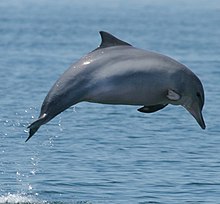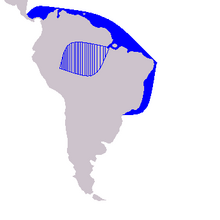| Guiana dolphin | |
|---|---|

| |
| Guiana dolphin | |

| |
| Size compared to an average human | |
|
Scientific classification
| |
| Domain: | Eukaryota |
| Kingdom: | Animalia |
| Phylum: | Chordata |
| Class: | Mammalia |
| Order: | Artiodactyla |
| Infraorder: | Cetacea |
| Family: | Delphinidae |
| Genus: | Sotalia |
| Species: | S. guianensis
|
| Binomial name | |
| Sotalia guianensis (
van Bénéden, 1864)
| |

| |
| Range of Guiana dolphin(coastal–solid pattern) and tucuxi (inland–hatched pattern) | |
The Guiana dolphin (Sotalia guianensis), also known as the estuarine dolphin or costero, is a dolphin found in the coastal waters to the north and east of South America, and east of Central America. It is a member of the oceanic dolphin family (Delphinidae). It can live in both saltwater and freshwater.
Etymology
During its 2008 Annual Meeting in Santiago, Chile, as proposed by Flores et al. (2008), the Scientific Committee of the International Whaling Commission (IWC) endorsed ‘Guiana dolphin’ as the common English name for (Sotalia guianensis) in its IWC List of Recognized Cetacean Species (LRCS). Furthermore, the common name "Guiana dolphin" has been suggested by Flores and colleagues. [3]
Description
The Guiana dolphin (Sotalia guianensis) is frequently described as looking similar to the bottlenose dolphin. However, it is typically smaller, at only up to 2.1 m (6.9 ft) in length. The dolphin is coloured light to bluish grey on its back and sides. The ventral region is light grey. The dorsal fin is typically slightly hooked, with a triangular shape. The beak is well-defined and of moderate length.
Guiana dolphins are very inconspicuous, and they do not bow ride on boats and normally swim away from them.
Researchers have recently shown that the costero has an electroreceptive sense, and speculate this may also be the case for other odontocetes. [4]
Taxonomy
Although described as species distinct from the tucuxi Sotalia fluviatilis by Pierre-Joseph van Bénéden in 1864, the costero Sotalia guianensis has subsequently been synonymized with Sotalia fluviatilis with the two species being treated as subspecies, or marine and freshwater varieties. [5] The first to reassert differences between these two species was a three-dimensional morphometric study of Monteiro-Filho and colleagues. [6] Subsequently, a molecular analysis by Cunha and colleagues [7] unambiguously demonstrated that Sotalia guianensis was genetically differentiated from Sotalia fluviatilis. This finding was reiterated by Caballero and colleagues [8] with a larger number of genes. The existence of two species has been generally accepted by the scientific community;. [9]
Distribution
The costero is found close to estuaries, inlets and other protected shallow-water areas around the eastern and northern South American coast. It has been reported as far south as southern Brazil and north as far as Nicaragua. One report exists of an animal reaching Honduras.
34 survive in Guanabara Bay near Rio de Janeiro, down from 70 in 1995 and 400 in 1985. [10]
Food and foraging
More than 60 species of demersal and pelagic schooling fish have been reported as prey. Small fish of 8 in (20 cm) or less are preferred. Foraging may be carried out individually or in groups. Different dolphin communities may adopt their own foraging strategies based on local circumstances. One of the best studied groups herds fish onto beaches and half strands themselves for a few seconds while grabbing their prey. [11]
Behaviour
This species forms small groups of about 2-10 individuals, occasionally up to 100, and swim in tight-knit groups, suggesting a highly developed social structure. They are quite active and may jump clear of the water (a behaviour known as breaching), somersault, spy-hop or tail-splash. They are unlikely, however, to approach boats. They feed on a wide variety of fish, shrimps and squid. Studies of growth layers suggest the species can live up to 30 years.
In December 2006, researchers from the Southern University of Chile and the Rural Federal University of Rio de Janeiro witnessed attempted infanticide by a group of costeros in Sepetiba Bay, Brazil. [12] A group of six adults separated a mother from her calf, four then keeping her at bay by ramming her and hitting her with their flukes. The other two adults rammed the calf, held it under water, then threw it into the air and held it under water again. The mother was seen again in a few days, but not her calf. Since females become sexually receptive within a few days of losing a calf, and the group of attacking males were sexually interested in the female, it is possible that the infanticide occurred for this reason. [13] Infanticide has been reported twice before in bottlenose dolphins but is thought to be generally uncommon among cetaceans. [13]
Conservation
The costero is listed on Appendix II [14] of the Convention on the Conservation of Migratory Species of Wild Animals ( CMS). It is listed on Appendix II [14] as it has an unfavourable conservation status or would benefit significantly from international co-operation organised by tailored agreements. As with all coastal cetaceans, the Guiana dolphin suffers from negative interactions with humans. Entanglement in gill nets, seine nets, and shrimp traps is responsible for the death of many animals each year. There is very limited gene flow between concentrations of this dolphin, and large stretches of coast contain no animals at all, so recovery from depletion of a local population may take time. [11]
See also
References
- ^ Secchi, E.; Santos, M.; Reeves, R. (2019) [errata version of 2018 assessment]. "Sotalia guianensis". IUCN Red List of Threatened Species. 2018: e.T181359A144232542. doi: 10.2305/IUCN.UK.2018-2.RLTS.T181359A144232542.en.
- ^ "Appendices | CITES". cites.org. Retrieved 14 January 2022.
- ^ Flores, PAC; Bazzalo, M; Santos, MC; Rossi-Santos, MR; Trujillo, F; Bolaños-Jimenez, J; Cremer, MJ; May-Colado, LJ; Silva, FJL; Montiel-Villalobos, MG; Azevedo, AF; Meirelles, ACO; Flach, L; Barrios-Garrido, H; Simões-Lopes, PC; Cunha, HA; van Waerebeek, K (2010). "Proposed English common name for the neotropical delphinid Sotalia guianensis (P.-J. Van Beneden, 1864)". Latin American Journal of Aquatic Mammals. 8 (1–2): 179–181. doi: 10.5597/lajam00167.
- ^ Nicole U. Czech-Damal; Alexander Liebschner; Lars Miersch; Gertrud Klauer; Frederike D. Hanke; Christopher Marshall; Guido Dehnhardt; Wolf Hanke (2011). "Electroreception in the Guiana dolphin (Sotalia guianensis)". Proc. R. Soc. B. 279 (1729): 663–8. doi: 10.1098/rspb.2011.1127. PMC 3248726. PMID 21795271.
- ^ Borobia, M.; S. Siciliano; L. Lodi & W. Hoek (1991). "Distribution of the South American dolphin Sotalia fluviatilis". Canadian Journal of Zoology. 69 (4): 1024–1039. doi: 10.1139/z91-148.
- ^ Monteiro-Filho, E.L.D.A.; L. Rabello-Monteiro & S.F.D. Reis (2008). "Skull shape and size divergence in dolphins of the genus Sotalia: A morphometric tridimensional analysis". Journal of Mammalogy. 83: 125–134. doi: 10.1644/1545-1542(2002)083<0125:SSASDI>2.0.CO;2.
- ^ Cunha, H.A.; V.M.F. da Silva; J. Lailson-Brito Jr.; M.C.O. Santos; P.A.C. Flores; A.R. Martin; A.F. Azevedo; A.B.L. Fragoso; R.C. Zanelatto & A.M. Solé-Cava (2005). "Riverine and marine ecotypes of Sotalia dolphins are different species". Marine Biology. 148 (2): 449–457. Bibcode: 2005MarBi.148..449C. doi: 10.1007/s00227-005-0078-2. S2CID 49359327.
- ^ Caballero, S.; F. Trujillo; J. A. Vianna; H. Barrios-Garrido; M. G. Montiel; S. Beltrán-Pedreros; M. Marmontel; M. C. Santos; M. R. Rossi-Santos; F. R. Santos & C. S. Baker (2007). "Taxonomic status of the genus Sotalia: species level ranking for "tucuxi" (Sotalia fluviatilis) and "costero" (Sotalia guianensis) dolphins". Marine Mammal Science. 23 (2): 358–386. Bibcode: 2007MMamS..23..358C. doi: 10.1111/j.1748-7692.2007.00110.x.
- ^ Secchi, E.; Santos, M.C. de O.; Reeves, R. (2018). "Sotalia guianensis". IUCN Red List of Threatened Species. 2018: e.T181359A144232542. doi: 10.2305/IUCN.UK.2018-2.RLTS.T181359A144232542.en. Retrieved 12 November 2021.
- ^ "Rio 2016: Dolphins threatened by toxic waters where sailing event to be held". Australian Broadcasting Corporation. 27 June 2016. Retrieved 16 July 2016.
- ^ a b Berta, Annalisa, editor. Whales, Dolphins & Porpoises: A Natural History and Species Guide. University of Chicago Press, 2015.
- ^ "Dolphins seen trying to kill calf". BBC News. 18 May 2009. Retrieved 30 April 2010.
- ^ a b Nery, M. F.; S. M. Simão (2009). "Sexual coercion and aggression towards a newborn calf of marine tucuxi dolphins (Sotalia guianensis)". Marine Mammal Science. 25 (2): 450–454. Bibcode: 2009MMamS..25..450N. doi: 10.1111/j.1748-7692.2008.00275.x.
- ^ a b " Appendix II Archived 21 February 2012 at the Wayback Machine" of the Convention on the Conservation of Migratory Species of Wild Animals (CMS). As amended by the Conference of the Parties in 1985, 1988, 1991, 1994, 1997, 1999, 2002, 2005 and 2008. Effective: 5 March 2009. Convention on Migratory Species page on the Guiana dolphin Archived 20 May 2013 at the Wayback Machine
- Flach, Leonardo; Flach, Patricia Amaral; Chiarello, Adriano G (2008). "Density, abundance and distribution of the Guiana dolphin (Sotalia guianensis van Benéden, 1864) in Sepetiba Bay, Southeast Brazil". Journal of Cetacean Research and Management. 10 (1): 31–36. doi: 10.47536/jcrm.v10i1.657. ISSN 1561-0713. S2CID 256922954.
- Rosas, Fernando C Weber; Monteiro-Filho, Emygdio LA (2002). "Reproduction of the Estuarine Dolphin (Sotalia guianensis) on the Coast of Paraná, Southern Brazil". Journal of Mammalogy. 83 (2): 507–515. doi: 10.1644/1545-1542(2002)083<0507:ROTEDS>2.0.CO;2.
External links
- IUCN Red List near threatened species
- Electroreceptive animals
- Mammals of the Caribbean
- Mammals of Brazil
- Mammals of Colombia
- Mammals of Central America
- Vertebrates of Costa Rica
- Mammals of French Guiana
- Mammals of Guyana
- Vertebrates of Honduras
- Vertebrates of Panama
- Mammals of Suriname
- Mammals of Trinidad and Tobago
- Mammals of Venezuela
- Mammals described in 1864
- Marine fauna of South America
- Oceanic dolphins
